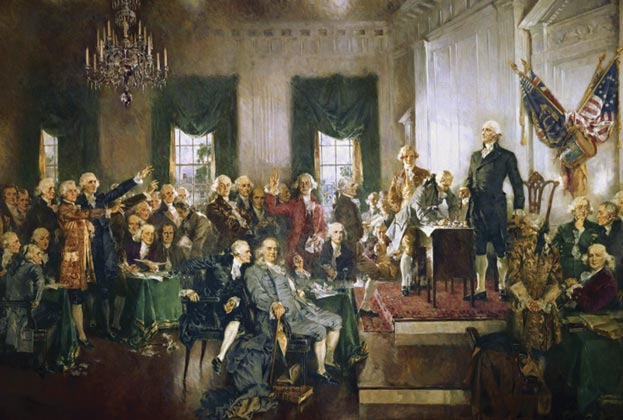SPRING 2025

By John Howard
When Americans think of tariffs today, they often picture trade wars, pricey foreign goods, political brinkmanship, or enigmatic World Trade Organization ("WTO") disputes. But for most of U.S. history, tariffs were not just economic tools—they were foundational to the country's legal identity, fiscal policy, and constitutional evolution. They were and are woven into the fabric of the nation's history, serving as tools for revenue generation, industrial protection, and even political controversy. While modern discussions about tariffs often spark heated debates, their historical evolution offers a fascinating glimpse into how economic policy has shaped society. This article explores the history of tariffs in the United States, highlighting key moments that demonstrate their importance and impact.
When the United States gained independence in 1776, it faced a monumental challenge: funding a government without relying on direct taxation. The Constitution gave Congress the power "[t]o lay and collect Taxes, Duties, Imposts and Excises,"1 and it is no accident that tariffs were the earliest and most important use of this power. With no income tax system in place until 1913, tariffs quickly emerged as the primary source of federal revenue in the late 18th and 19th centuries.2 The new nation's first major piece of legislation, the Tariff Act of 1789,3 passed just weeks after the First Congress convened and was signed into law by President George Washington. Proposed by Alexander Hamilton, it served two purposes: to generate revenue for a cash-strapped federal government and to protect fledgling American industries from British competition.
Hamilton's vision for tariffs was both pragmatic and forward-thinking. In his Report on Manufactures (1791),4 he argued that tariffs could serve dual purposes: to provide essential funds for government operations and to foster economic independence by shielding American manufacturers from foreign competition. At the time, the United States was heavily reliant on imported goods from Europe, particularly Britain. Hamilton believed that nurturing domestic production would strengthen the nation's economy and reduce its vulnerability to external pressures.5
For decades following the 1789 Act's passage, tariffs accounted for over 90% of federal revenue—a testament to their importance in early American governance.6 This reliance on tariffs persisted until the introduction of income taxes through the Sixteenth Amendment in 1913.7 Tariffs helped build the legal and political framework of the United States, and lawyers have always been at the center of developing and maintaining them all. Indeed, American lawyers were litigating over sugar duties and wool rates at ports from Charleston to New York before "international trade law" became its own discipline.
As the United States transitioned from an agrarian economy to an industrial one during the 19th century, the central role of tariffs was to protect emerging industries. The concept of shielding "infant industries" from foreign competition gained traction among policymakers who feared that emerging American manufacturers would struggle against more established European rivals.8 A notable example was Henry Clay's "American System,"9 which was a series of economic policies designed to promote domestic manufacturing through protective tariffs, infrastructure development, and a national bank. Clay envisioned high tariff rates as a means to nurture industries such as textiles and steel, while generating revenue for internal improvements, including roads and canals.10 These protective measures allowed industries to flourish during America's industrial revolution. By imposing high duties on imported goods, policymakers effectively incentivized domestic production while discouraging reliance on imports. For example, tariffs helped establish Pennsylvania as a hub for iron production and New England as a center for textile manufacturing.11
The Constitution gave Congress control over tariffs, but it also left the door open to legal and political conflict. The Commerce Clause12 and the Treaty Clause13 gave the federal government broad power to regulate trade and enter into international agreements, but who defined the limits? And what happened when federal tariff law clashed with local economic interests?
Protective tariffs were not universally embraced, and over time tariff disputes began to erupt. Southern states, which relied heavily on agricultural exports and imported goods, often opposed high tariffs. They viewed these measures as benefiting northern manufacturers at their expense—a source of growing regional tension.
This North-South tension culminated in one of the most infamous tariff laws in U.S. history: the Tariff of Abominations (1828).14 The law raised duties on imported goods to...
